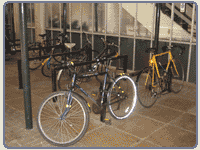
 |
|
  
|
Taxonomy and description Terminology Technology  Terminology Terminology
A bicycle does not demand much space. In contrast to cars, bicycles can in principle easily be parked on many places even if no special area is provided for this purpose. They can also be parked much closer to the destination than cars can. Cycle parking provision can consist of the following managerial measures, alone or combined:
Cycle parking facilities must be located close to the entrance of the actual destination. If located further away, cycles will be parked elsewhere and maybe at places where one does not want cyclists to park. Priority should be given to destinations known to have many bikers, like work places, shopping and leisure facilities (Solheim 1997), cf. Cycle routes, where figures on different types of cyclists and destinations are given. The Dutch Ministry of Transport recommends the following numbers of bicycle parking places on different locations (CROW 1997):
Cycle parking facilities can be achieved by reallocating outside or inside space originally used for other objectives, e.g. car parking, pavements etc. Providing cycle parking space can also be an infrastructure measure, and it is recommended that such facilities get integrated in infrastructure planning; e.g. as a part of cycle networks, cf. Cycle routes (link). Separate cycle parking areas can be planned at public transport stations or terminals, cf Park and ride (link) or close to other important urban activities, and can be of different size and quality. Infrastructure measures are not dealt with in this section. Cycle parking facilities could favourably be combined with informative measures like maps showing where such parking is provided. Furthermore it is utmost important to develop a cycle parking policy integrated in a cycling policy and again integrated in the urban transport policy, cf. Case 1. Technology
The Dutch Ministry of Transport has published a guideline for cycling
parking (CROW 1996), where practical solutions are described. Many of
these are also included in the CD ROM catalogue from the EU project ADONIS
which contains 60 measures to promote cycling (EU & Road Directory
1998). These references gives examples of good practice with photos and
diagrams as well as detailed information on layout design, dimensions
and cost estimates.
|